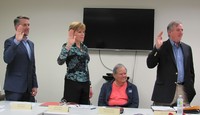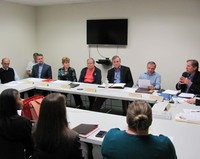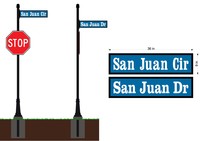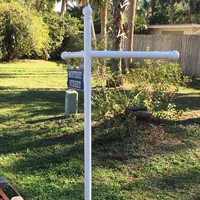



After Kitty Switkes, Brad Wester and John Cellucci were sworn into office as Municipal Service District (MSD) board trustees at the MSD meeting Dec. 12, their first order of business was certainly not a new project. But, it definitely wasn’t one they anticipated when they campaigned just a few months ago.
The three new members were elected to the board in August, just five weeks before Hurricane Matthew wreaked havoc along the coastline, washing away miles of protective barrier dunes. It was the first major hurricane to hit the First Coast in more than 50 years.
“There’s always something going on in the MSD,” Switkes said. “There’s always a reason why we’re there to help the residents. But, the hurricane wasn’t on my list. That wasn’t even in the equation then.”
With dune restoration and Hurricane Matthew recovery at the top of the MSD meeting agenda for the past three months, it’s certainly in the equation now, and Switkes, Wester and Cellucci will have the opportunity to address and resolve it over the next four years.
To help them in doing so, the MSD board hosted St. Johns County Public Works Director Neal Shinkre and Florida Department of Environmental Protection (DEP) representatives Alex Reed, Celora Jackson and Carla Gaskin Mautz at the meeting in the Ponte Vedra Beach Library to review county and state dune restoration plans and answer residents’ questions.
Reed is the administrator of the beaches funding program. She said the DEP is drafting a hurricane recovery plan for the Florida Legislature to review so the state can decide where to allocate funding for beach nourishment programs.
Reed said DEP funding is issued to areas that are listed as “critically eroded” shorelines, meaning they have demonstrated long-term erosional trends over time rather than one dramatic erosional event. To the uneasiness of meeting attendees, she said the MSD’s beaches have not been historically designated as “critically eroded.”
Despite that fact, the DEP is working with St. Johns County and the U.S. Army Corps of Engineers to collect and analyze pre- and post-storm data that illustrates what happened during the storm, where sand was lost and where the priority for sand placement will be. Once the department has that analysis, Reed said, it can determine whether the shoreline in the MSD should be designated as “critically eroded” and included in the hurricane recovery plan as eligible for state assistance. The DEP is hoping to arrive at a conclusion on this in March or April.
Shinkre also promised progress from the county over the next few months. In addition to working on the pre- and post-storm data with the Army Corps of Engineers and DEP, he said county officials are meeting with FEMA representatives in early January for a kickoff meeting to review Hurricane Matthew recovery plans. After the meeting, Shinkre said, the county will have 60 days to produce a document that outlines the impacts of the storm and the projects that FEMA should consider for reimbursement. The public works director said the county is hiring an engineering consulting firm to help navigate through these DEP and FEMA processes.
After Shinkre and the DEP representatives discussed their plans with residents, MSD Vice Chairman John Wegl asked the question that other residents in the room feared to ask.
“It certainly is good to hear there are a lot of things that are going on right now,” said Wegl. “But hurricane season starts again in about five months, and I think that what I’m hearing is all of this is going to take a lot longer than five months. Right?”
Wegl’s rhetorical question elicited nods of agreement from the county and state officials sitting around the room.
Compared to the raucous reactions from residents that characterized November’s MSD meeting, attendees seemed to be more accepting of their new reality.
“What I’ve been hearing throughout all of this is the county does have this holistic problem,” resident David Delaney said. “They have to look at a lot of places that are quite frankly in probably much greater need than a bunch of homeowners in Ponte Vedra that want their dunes restored.
“I think we have to accept the fact that if you have a home on the beach here, you’re way down on the totem pole in terms of what the county is going to worry about. I think the homeowners are kind of on their own to solve their own problems, or they’re going to be waiting a long time through a lot of hurricanes to try to get anything they’re not going to pay for themselves.”
Shinkre assured meeting attendees that government officials are moving as quickly as they can.
“I know it doesn’t seem like something is happening, but there’s tremendous work that’s being done daily” said Shinkre. “The goal is to get sand and protect the homes. But there is a process. There’s a methodology. It cannot happen right away.”
For residents that voluntarily decide to pay for dune restoration projects, the question of whether FEMA will reimburse them remains unanswered. Reed suggested that residents contact the agency as soon as possible to find out and start any necessary paperwork. Celora Jackson, who is the state coastal armoring permit manager for the DEP, said residents can extend permits for these projects if needed.
MSD Chairman Gary Jurenovich has said the board will continue to address dune restoration at future meetings. The next MSD meeting will be held Jan. 9 at 6:30 p.m. in the small conference room of the Ponte Vedra Beach Library.